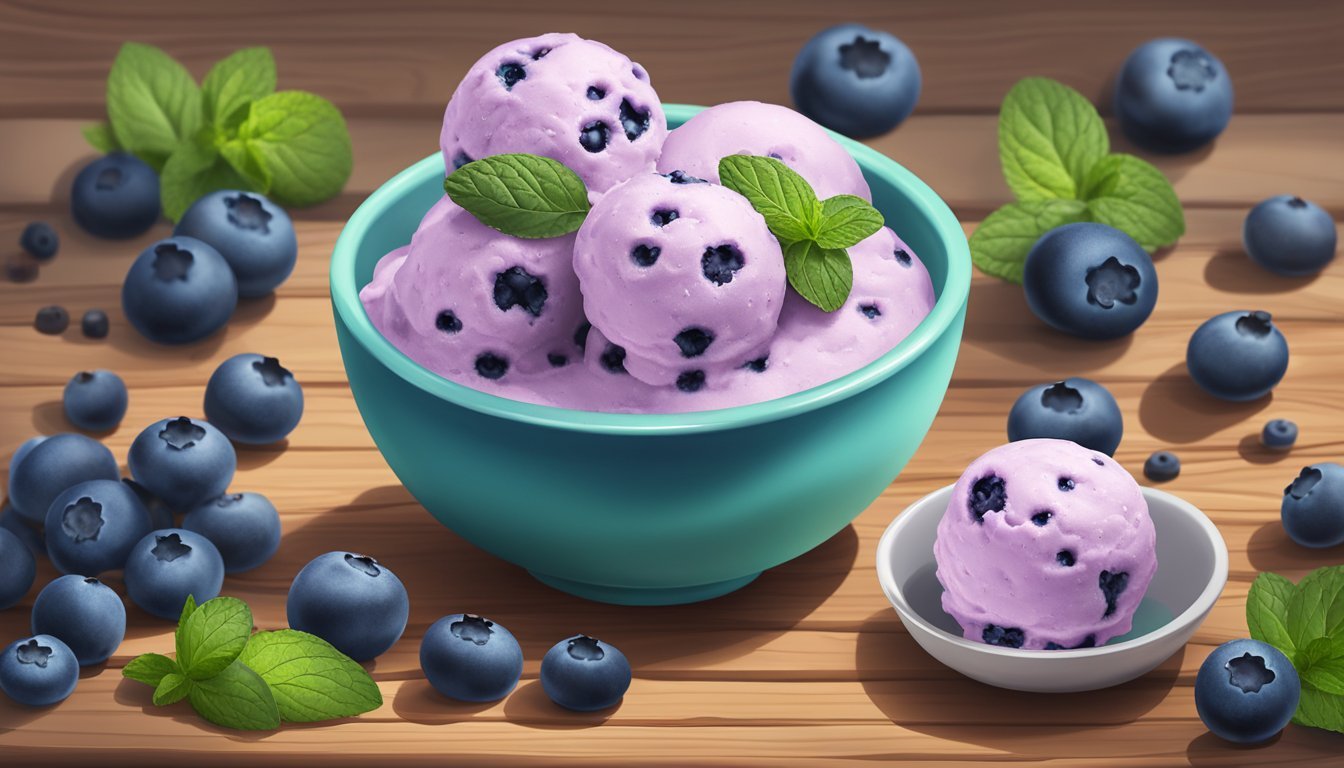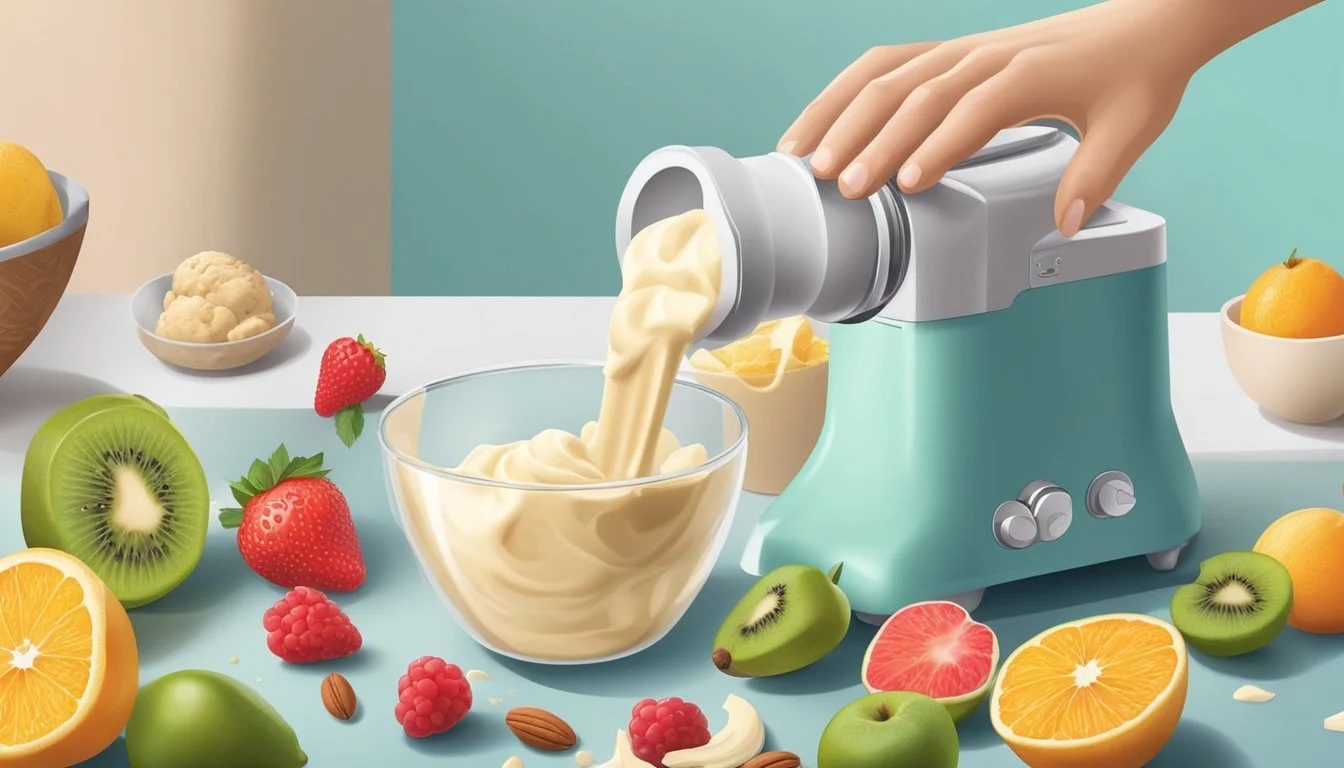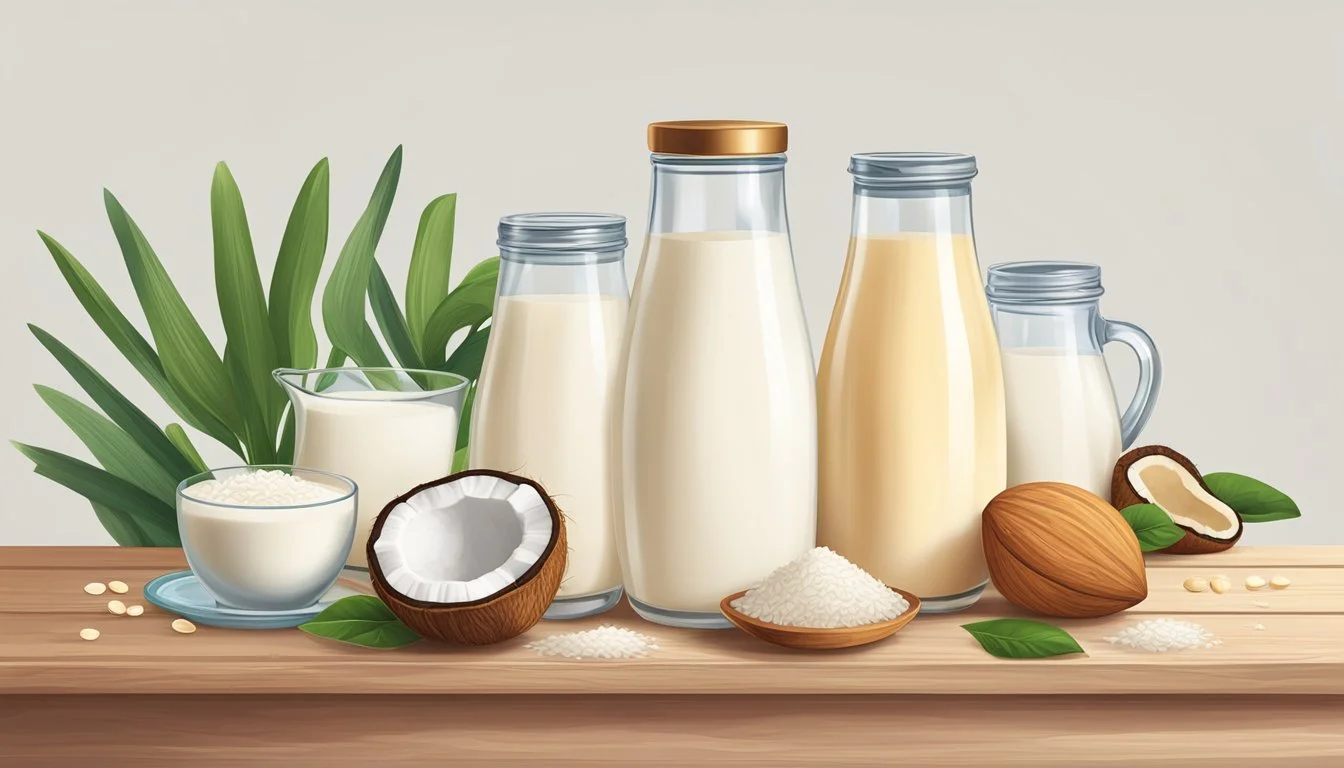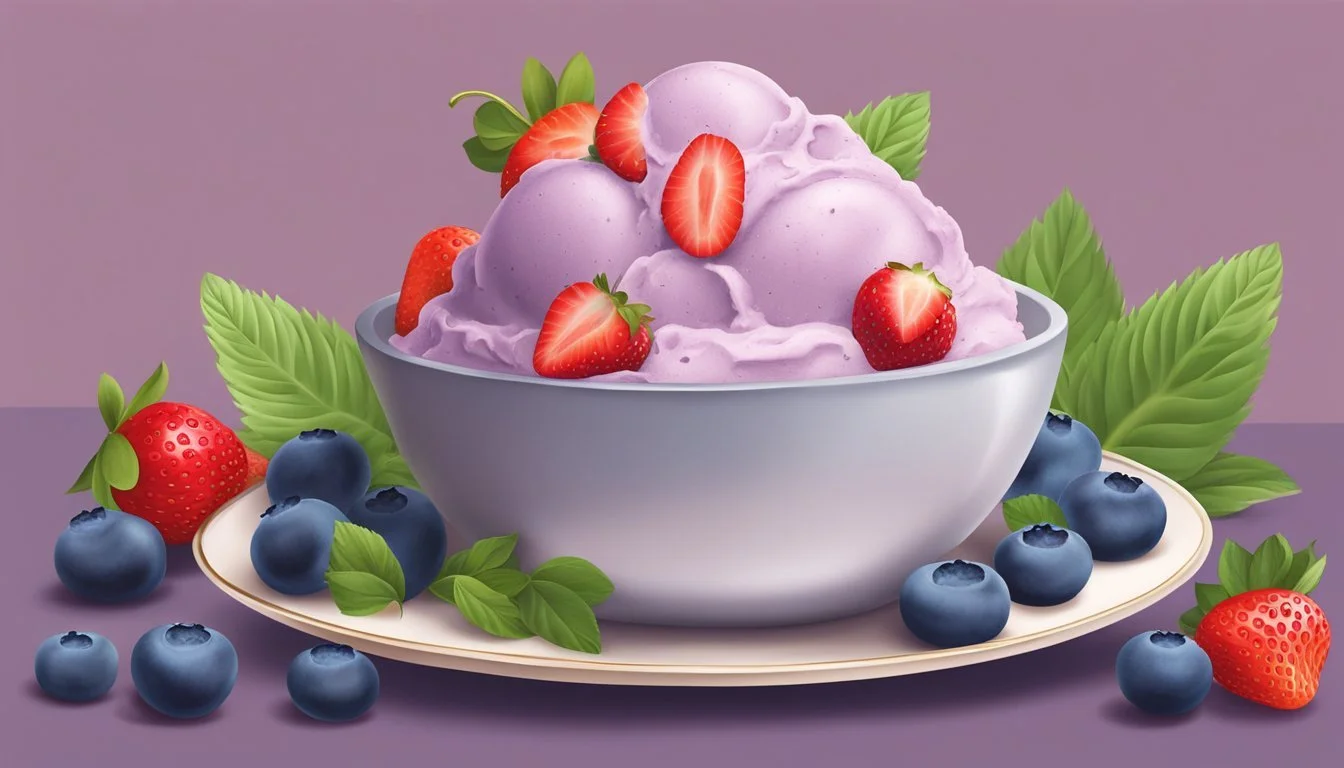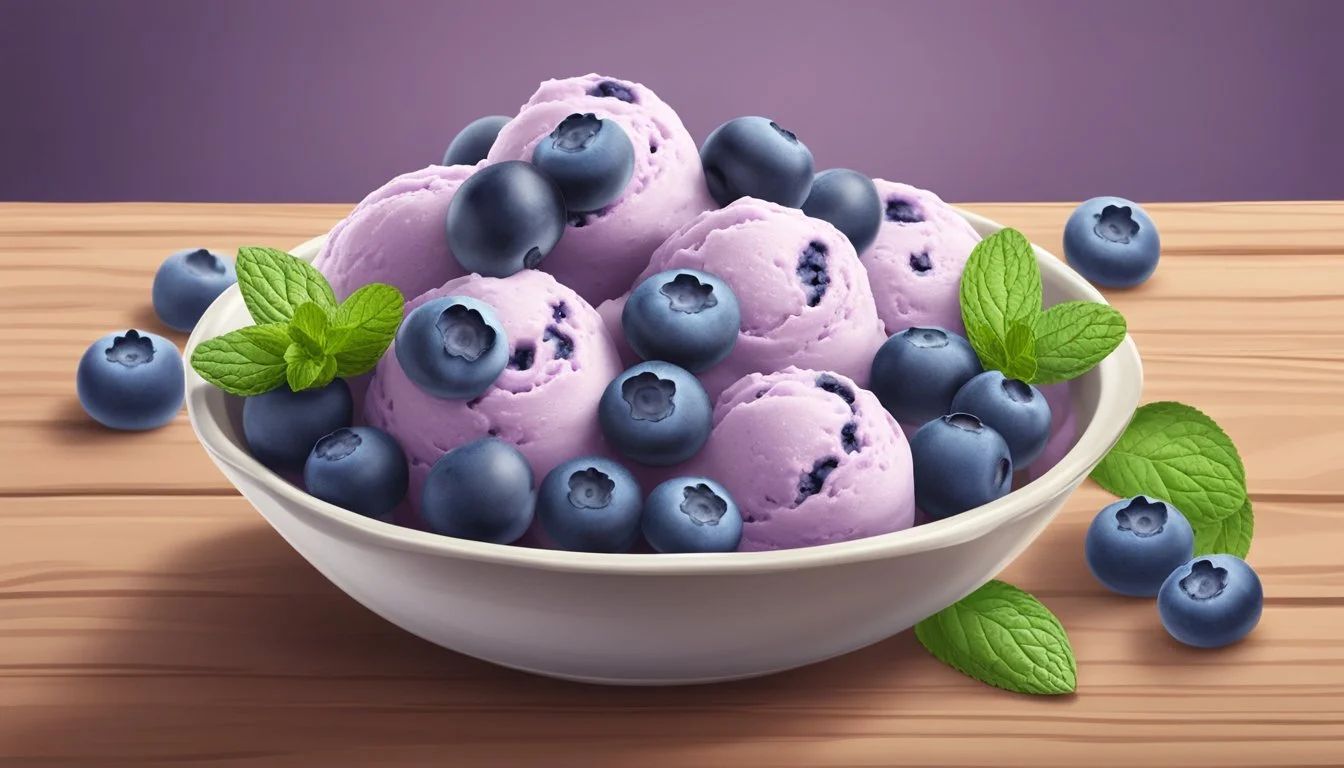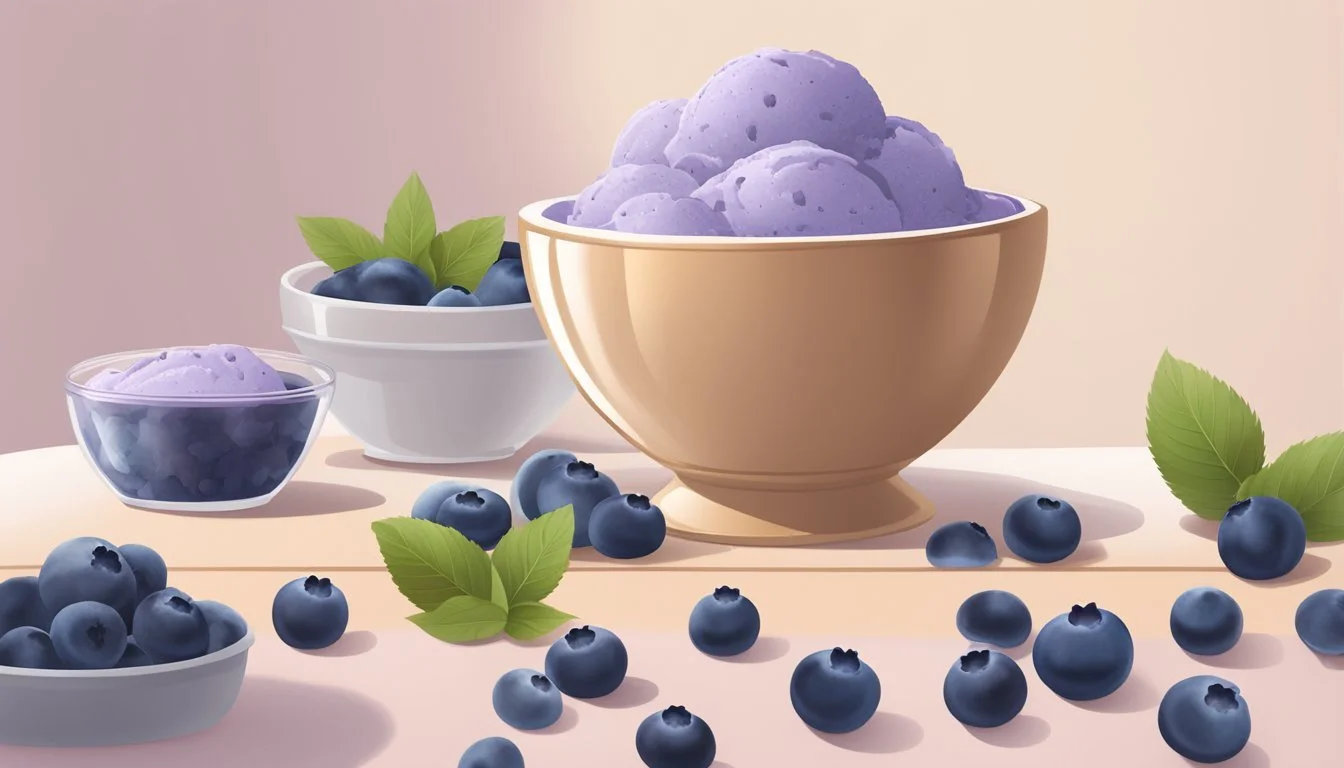Homemade Blueberry Ice Cream | Dairy-free
Your Ultimate Guilt-free Dessert Guide
Discover > Texas Recipes > Homemade Blueberry Ice Cream | Dairy-free
Homemade Blueberry Ice Cream (how long does cream last?) is a delicious and refreshing treat that can be enjoyed by everyone, especially those who are lactose intolerant or looking for a dairy-free option. As the popularity of plant-based diets and dairy alternatives continues to grow, more and more people are discovering the joys of creating delectable dairy-free desserts at home. This homemade blueberry ice cream recipe delivers a creamy and flavorful experience without the need for dairy products, ensuring that it can be enjoyed by all and have a fun time.
Utilizing simple, easily obtainable ingredients, this recipe provides an easy prep time and an uncomplicated way to create a scrumptious dessert. With its delightful taste and smooth texture, this homemade amazing blueberry ice cream is sure to impress friends, family, and anyone else who has the opportunity to try it. Not only is it a healthier alternative to traditional ice cream, but it also offers a sense of satisfaction that comes with crafting a delicious treat from scratch.
When looking for a tasty dairy-free dessert option, homemade blueberry ice cream is a top choice. By following a few easy steps and using easily accessible ingredients, one can indulge in a delightful, refreshing dessert that is also friendly to those with dietary restrictions. With its versatile flavor, this ice cream is perfect for serving at gatherings, enjoying as a late-night snack, or simply savoring on a warm summer day.
Understanding Dairy-Free Ice Cream
Dairy-free ice cream, a delightful alternative for those seeking a lactose-free treat, is often made with a base of frozen blueberries and fresh berries. The process involves blending frozen berries into a creamy ice cream texture and storing the mixture in a freezer-safe container. This ensures the delectable result is not only rich in flavor but also suitable for those with dairy sensitivities.
When it comes to enjoying a delicious frozen treat, dairy-free ice cream offers a fantastic alternative for those who cannot or choose not to consume dairy products. In recent years, the popularity of non-dairy ice creams has soared, making it easier for consumers to find options that cater to their dietary preferences and needs.
Experimenting with various combinations of frozen and fresh berries allows for a diverse range of dairy-free ice cream options. To achieve the perfect consistency, it may be necessary to blend the mixture a couple of times during the freezing process.
To create dairy-free ice cream, manufacturers replace milk and milk-based products with plant-based alternatives. Some of the most common ingredients found in non-dairy ice creams include coconut milk, almond milk (how long does almond milk last?), soy milk, (how long does soy milk last?) cashew milk, and oat milk (how long does oat milk last?). These alternatives not only provide the creamy texture associated with traditional ice cream but also come with their own unique flavors.
When selecting the perfect dairy-free ice cream, it's essential to understand the different ingredients used in the various options available in the market. The table below offers a brief overview of these ingredients and their distinct characteristics:
Coconut Milk
Texture: Creamy
Flavor Profile: Tropical, slightly sweet
Nutritional Highlights: High in saturated fat, low in protein
Almond Milk
Texture: Smooth
Flavor Profile: Nutty, mild
Nutritional Highlights: Low in calories, moderate in protein
Soy Milk
Texture: Thick
Flavor Profile: Beany, mild to moderately sweet
Nutritional Highlights: Low in fat, high in protein
Cashew Milk
Texture: Creamy
Flavor Profile: Mildly nutty, subtle
Nutritional Highlights: Low in calories, moderate in protein
Oat Milk
Texture: Thick
Flavor Profile: Slightly sweet, slight grainy taste
Nutritional Highlights: Low in fat, moderate in protein
It's crucial to note that while dairy-free ice creams eliminate the need for cow's milk and other dairy products, they may not necessarily be healthier than traditional ice cream. This greatly depends on the specific product and its ingredients. For example, ice creams made with coconut milk can be high in saturated fat, whereas almond milk-based ice creams may be lower in calories. Additionally, some non-dairy ice creams can have higher sugar (how long does sugar last?) content, so it's essential to check the labels before making a selection.
Understanding the various aspects of dairy-free ice cream and being familiar with the different ingredients will help consumers make informed decisions when choosing a non-dairy frozen treat that best suits their taste and nutritional preferences. By embracing dairy-free alternatives and the versatility of berries, individuals can enjoy a satisfying frozen treat that aligns with their dietary preferences.
Why Homemade Ice Cream?
Making homemade ice cream has numerous benefits for those who prefer a more natural, dairy-free frozen treat during the warm summer months. One of the main advantages is that it allows you to manage the quality of the ingredients in your dessert. The ingredients of store-bought ice creams often include additives and preservatives to extend shelf-life; however, homemade ice cream ensures that your dessert is made from fresh, natural ingredients.
When making ice cream at home, you have the freedom to customize the flavors according to your preferences and dietary needs. Homemade blueberry ice cream is a popular summer treat that many people enjoy not only because it tastes delicious but also because blueberries are rich in antioxidants and offer numerous health benefits.
Here are some reasons why many people choose to make blueberry ice cream at home:
Freshness: Homemade ice cream guarantees a fresh, just-made taste that may not be present in store-bought ice creams.
Control: Making ice cream at home lets you tweak the sweetness and adjust the recipe to your liking.
Dairy-free options: Those with lactose intolerance or preferences for plant-based diets can still enjoy ice cream by using dairy-free alternatives like almond milk, coconut milk, or cashew milk.
No additives: Homemade ice cream doesn't require any artificial colors, flavors, or preservatives, which can be found in some store-bought ice creams.
Blueberry ice cream is a delicious and refreshing frozen treat to enjoy during the summer months. By making it homemade, you ensure that your dessert is made from the freshest ingredients and is free from unhealthy additives. Furthermore, homemade ice cream allows you to create a unique dessert tailored to your dietary needs and taste preferences.
The Base: Choosing Your Milk
When it comes to creating homemade blueberry ice cream that is dairy-free, the choice of milk base is crucial for both flavor and texture. The most popular options for a non-dairy ice cream are coconut milk, almond milk, cashew milk, and rice milk (how long does rice milk last?). Each of these alternatives offers unique characteristics, so let's explore the pros and cons of each one.
Coconut milk is a rich, creamy option that lends a luscious texture to the ice cream. Its natural sweetness pairs well with the fruity flavor of blueberries. However, those who are not fans of the hint of coconut flavor it imparts may wish to explore other alternatives.
Pros:
Creamy texture
Natural sweetness
Cons:
Coconut flavor may be overpowering for some
Almond milk is another popular choice for dairy-free ice cream. It boasts a subtle, nutty flavor that complements the berries well. However, its thinner consistency requires additional ingredients like thickeners or stabilizers to achieve the desired creaminess.
Pros:
Subtle, nutty flavor
Pairs well with berries
Cons:
Requires thickeners or stabilizers
Cashew milk has a mildly sweet and buttery taste that works nicely with blueberries. Its creamy consistency can be attributed to the high-fat content, which helps in achieving the desirable texture. The downside is, it may be harder to find in stores compared to almond or coconut milk.
Pros:
Creamy texture
Mildly sweet and buttery taste
Cons:
Less widely available
Rice milk is a lighter alternative for those who prefer a less-rich ice cream. Its subtle sweetness and neutral taste allow the blueberry flavor to shine. However, like almond milk, it requires thickeners or stabilizers to enhance the texture.
Pros:
Light and refreshing
Subtle sweetness
Cons:
Requires thickeners or stabilizers
Choosing the right milk base for homemade dairy-free blueberry ice cream is a matter of personal taste, availability, and considerations for texture. While coconut and cashew milk provide a creamier texture, almond and rice milk may require additional ingredients to achieve the desired consistency. Ultimately, experimenting with different milk bases and adjustments is the key to finding the perfect recipe.
Sweeteners for Dairy-free Ice Cream
When making homemade blueberry ice cream that is dairy-free, the choice of sweeteners is crucial to achieving the desired taste and texture. A wide variety of natural sweeteners can be used, each offering its unique flavor profile and health benefits.
Sugar: Traditional white sugar or cane sugar is a common choice in ice cream recipes, known to provide the classic sweet taste and smooth texture. However, it's essential to consider the risks associated with consuming refined sugars and possibly opt for healthier alternatives.
Honey (how long does honey last?): A natural and versatile option, honey is popular for its rich flavor and easy incorporation into recipes. It has a lower glycemic index than white sugar and offers antioxidants which may benefit your health. Keep in mind that honey can be overpowering in flavor, so adjust the amount according to your taste preference.
Coconut Sugar: (how long does coconut sugar last?) Derived from the sap of the coconut palm tree, coconut sugar boasts a lower glycemic index than regular sugar and has a rich, caramel-like flavor. It is ideal for those looking for a more earthy and less processed option. Since it has a granulated texture similar to white sugar, it incorporates easily into recipes.
Maple Syrup: (how long does maple syrup last?) With its distinct taste and natural sweetness, maple syrup can create a unique twist to your dairy-free blueberry ice cream. It is often used as a vegan alternative to honey, and contains vitamins, minerals, and antioxidants. Keep in mind that its strong flavor may not be suitable for everyone.
Agave: Extracted from the agave plant, this sweetener is praised for its low glycemic index and neutral flavor. It is often used as a vegan alternative to honey and can effortlessly blend into the ice cream mixture. Be cautious with the quantity, as it is sweeter than sugar and requires less to achieve your desired sweetness.
Save time and effort by ordering cane sugar, honey, coconut sugar, maple syrup, and agave online!
Here's a quick comparison table for reference:
Sugar
Flavor: Sweet, neutral
Glycemic Index: High
Health Benefits: None
Honey
Flavor: Rich, distinctive
Glycemic Index: Low-Medium
Health Benefits: Antioxidants
Coconut Sugar
Flavor: Caramel, earthy
Glycemic Index: Low-Medium
Health Benefits: Mineral content, less processed
Maple Syrup
Flavor: Distinctive
Glycemic Index: Medium
Health Benefits: Vitamin, mineral, and antioxidant content
Agave
Flavor: Mild, neutral
Glycemic Index: Low
Health Benefits: Low glycemic index
To enjoy your dairy-free blueberry ice cream to the fullest, experiment with different sweeteners to find the perfect balance between taste, texture, and health benefits. Make sure to adjust the proportions as needed and watch out for possible overpowering flavors that may affect the overall ice cream experience.
The Star Ingredient: Blueberries
Blueberries are the crowning jewel in this delicious homemade blueberry ice cream recipe. Their vibrant color and rich taste make them the perfect addition to the dairy-free dessert, creating a treat that is both visually appealing and incredibly satisfying to the palate.
Fresh blueberries are an excellent choice for this ice cream, as they provide a natural sweetness and are packed with healthy nutrients. These small, round berries are rich in antioxidants, vitamin C, fiber, and manganese, making them a great addition to your diet. In selecting blueberries for this recipe, look for plump, firm berries with a uniform deep blue color.
If fresh blueberries are not in season or readily available, wild blueberries can be a fantastic alternative. These berries are typically smaller and more intensely flavored than their cultivated counterparts. They are often found in the frozen fruit section of your local grocery store.
Here are some key differences to keep in mind when choosing between fresh and wild blueberries:
Fresh Blueberries
Feature: Larger
Flavor: Mild, sweet
Availability: Fresh or frozen
Antioxidant: High
Wild Blueberries
Feature: Smaller
Flavor: Intense, tangy
Availability: Typically frozen
Antioxidant: Higher
Regardless of the type of blueberry used in this recipe, you can be sure your homemade blueberry ice cream will be bursting with flavor and beneficial nutrients that the berry is known for. And remember, the more high-quality your star ingredient, the better your ice cream will taste, making it a dessert you can truly enjoy without any guilt.
Perfect Pairings: Blueberry Ice Cream and Others
When it comes to enjoying homemade blueberry ice cream, it's always a delightful experience to discover and experiment with complementary flavors. In this section, we'll explore some perfect pairings that can enhance and elevate the taste of your dairy-free blueberry ice cream.
A popular fruit often coupled with blueberries is the raspberry. Its tartness helps to balance the sweetness of the blueberry ice cream, creating a pleasant contrast. A simple way to incorporate raspberries is by folding them into the ice cream mixture before freezing. Alternatively, you can prepare a raspberry sauce or compote to drizzle on top of your finished ice cream.
Strawberries are another favorite pairing for blueberry ice cream. Like raspberries, their tangy flavor complements the sweetness of blueberries, while their soft texture adds some creaminess to the overall experience. To combine these flavors, you may either mix chopped strawberries into the blueberry ice cream or serve them on the side as a topping.
For a more indulgent pairing, consider adding chocolate chips (how long do chocolate chips last?) to your blueberry ice cream. The rich, velvety taste of chocolate balances the bright and fruity notes of the blueberries, while the bites of chocolate chips provide a nice contrast in texture. To try this delicious combination, simply stir in chocolate chips to your ice cream base or sprinkle them over the top as a garnish.
Lastly, a more unconventional but delightful pairing is blueberry ice cream with mint chocolate chip ice cream. The refreshing taste of mint and the crunchiness of the chocolate chips create an exciting contrast with the smooth, fruity blueberry flavor. Try serving a scoop of each flavor side by side or creating a marbled effect by gently swirling the two ice creams together when assembling.
Experimenting with these pairings is not only fun but can also lead to unexpected, delightful flavor combinations that will impress both you and your guests. Enjoy discovering new ways to enjoy your homemade, dairy-free blueberry ice cream!
Making and Freezing Your Ice Cream
To create your homemade dairy-free blueberry ice cream, you'll need a few essential tools, such as an ice cream maker or a blender. Additionally, you'll need a freezer to store the ice cream properly.
First, blend your base ingredients and blueberries together until smooth. This can be achieved with a high-powered blender or food processor. If you have an ice cream maker with a built-in churn, simply pour the mixture into the machine and follow the manufacturer's instructions. Usually, this involves letting the mixture churn for about 20-30 minutes.
If you don't have access to an ice cream maker, don't worry! You can still create a delicious dairy-free treat. Begin by pouring your blended mixture into a shallow container and placing it in the freezer.
Don't miss out on the ease and convenience of purchasing an ice cream maker, blender, or food processor online!
Ice Cream Maker Method:
Duration: 20-30 minutes
Manual Freezing Method:
Duration: 3-4 hours
For the manual freezing process, make sure to stir the mixture every 30-45 minutes to prevent ice crystals from forming and to achieve a creamy texture. This process takes approximately 3-4 hours until it reaches the desired consistency.
Before serving, it's crucial to let the blueberry ice cream sit at room temperature for about 5-10 minutes to soften. If you're not planning on consuming the entire batch right away, make sure to store the ice cream in an airtight container. It's recommended to use a layer of plastic wrap or parchment paper to minimize contact with air in the container. This will prevent ice crystals from forming on the surface and ensure it remains fresh.
In summary:
Blend base ingredients and blueberries.
Churn in an ice cream maker or manually stir in the freezer.
Allow to soften at room temperature before serving.
Store in an airtight container with a protective layer.
Troubleshooting Common Ice Cream Making Issues
When making homemade dairy-free blueberry ice cream, it's not uncommon to encounter some issues. In this section, you will find some common challenges and tips to address them, ensuring a creamy texture and delightful soft serve.
1. My ice cream is too icy or grainy.
Achieving a smooth and creamy texture can be a challenge, especially if you're not using dairy. To solve this issue, try:
Using high-fat non-dairy milk, like coconut milk, to maintain a creamy consistency.
Ensuring your ice cream maker is properly chilled before use.
Ensuring you are churning the ice cream mixture at the appropriate speed and duration for your specific ice cream maker.
2. My blueberry ice cream is not flavorful enough.
Nobody wants bland ice cream. Here are a few suggestions to amplify the blueberry flavor:
Use fresh, ripe blueberries instead of frozen or out-of-season ones.
Gently cook the blueberries in a saucepan with a little sugar and lemon juice to create a concentrated blueberry sauce. Stir this into your ice cream base before churning.
Add a touch of blueberry extract to your base for a more intense flavor.
3. My ice cream isn't setting properly.
If you're struggling with soft serve that's too soft, consider these tips:
Be patient and allow your ice cream to churn for the full recommended time.
Make sure your ice cream maker's bowl is thoroughly chilled in the freezer before using it.
After churning, transfer the ice cream to an airtight container and freeze for at least 2-4 hours for a firmer texture.
4. My ice cream is too sweet or not sweet enough.
To achieve the perfect sweetness, remember the following:
Taste your ice cream mixture before churning and adjust the sweetener as needed.
Keep in mind that once your ice cream is frozen, the sweetness level may taste slightly reduced.
Blueberries can vary in sweetness, so adjust your added sugar depending on the natural sugar content of your fruit.
In conclusion, don't hesitate to consult this section when encountering issues during your ice cream-making process. Following these tips and troubleshooting solutions will help you achieve a delicious and satisfying dairy-free blueberry ice cream that can be enjoyed by all.
Recipe Variations
There are plenty of ways to adapt this homemade blueberry ice cream recipe to suit different dietary preferences. Dairy-free alternatives play a key role in providing healthy substitutions for those who follow specific diets or have certain food allergies.
For a vegan and paleo friendly version, simply substitute regular milk with a plant-based alternative such as almond milk, coconut milk, or cashew milk. These non-dairy milks contribute to a creamy texture and enhance the flavor profile of the ice cream.
Keto dieters can enjoy this ice cream too by implementing a few modifications. Replace the sweetener with a keto-friendly alternative like erythritol (how long does erythritol last?) or stevia. Additionally, choose a higher fat dairy-free milk like coconut milk or an unsweetened almond milk to maintain the thick and creamy consistency that ice cream is known for.
If you're in the mood to indulge, consider adding mix-ins or toppings to personalize your blueberry ice cream. Here are a few ideas:
Crushed cookies (choose gluten-free or paleo-friendly options if needed)
Dark chocolate chips or cacao nibs (how long do cacao nibs last?)
Toasted nuts (how long do nuts last?) like almonds (how long do almonds last?) or walnuts (how long do walnuts last?)
Unsweetened shredded coconut (how long does shredded coconut last?)
For those who prefer a healthy boost in their dessert, the following ingredients can be added to the mix:
A scoop of protein powder (how long does protein powder last?) (vegan or paleo-friendly as needed)
A spoonful of chia seeds (how long do chia seeds last?) or flax seeds
A drizzle of nut butter, such as almond or cashew butter (how long does cashew butter last?).
No matter which variation(s) you choose, this homemade blueberry ice cream is sure to delight your taste buds and cater to your dietary preferences!
Nutrition Facts and Information
Homemade blueberry ice cream made with dairy-free ingredients can be a delicious and nutritious treat for those looking to indulge without the guilt. The following table presents an overview of the main nutritional components of this dessert:
Calories: 200
Carbohydrates: 28g
Saturated Fat: 1g
Sodium: 150mg
Fiber: 3g
Protein: 2g
The relatively low calorie count is a notable factor in this dairy-free blueberry ice cream recipe. By replacing heavy cream with healthier alternatives such as almond milk or coconut milk, the dish avoids excessive fat without sacrificing the creamy texture and indulgent taste.
With 28 grams of carbohydrates per serving, this dessert can provide a quick energy boost. The natural sugars in the blueberries contribute to the sweetness, while additional sweeteners like honey or agave syrup can be used in place of processed sugar to maintain a balanced and wholesome flavor profile.
The recipe's saturated fat content is minimal, measuring only 1 gram per serving - another testament to the benefits of using dairy-free ingredients. Healthy fats from ingredients such as almond milk or coconut milk can help lower cholesterol and improve overall heart health.
Considering sodium intake is important for maintaining a balanced diet, and this recipe's 150 milligrams per serving falls within an acceptable range. Keeping sodium levels in check may help prevent high blood pressure and support kidney function.
Adding blueberries to the ice cream not only provides a burst of fruity flavor, but also introduces 3 grams of fiber per serving. This insoluble fiber can aid in digestion and offer benefits for cardiovascular health.
While this dairy-free blueberry ice cream is relatively low in protein, providing 2 grams per serving, it can easily be incorporated into a diet complete with other protein-rich foods. Inclusion of a variety of nuts and seeds as toppings could provide an additional protein boost if desired.
Homemade dairy-free blueberry ice cream offers an array of nutritional benefits, making it a viable option for health-conscious dessert lovers. Its balance of carbohydrates, low saturated fat, moderate sodium, and inclusion of fiber-rich blueberries create a wholesome treat to be enjoyed in moderation.
Tasting and Serving Suggestions
Before indulging in the homemade blueberry ice cream, take a moment to appreciate its vibrant color and creamy texture. Dairy-free blueberry ice cream offers a slightly different taste profile compared to its traditional counterpart, with a refreshing, fruity taste.
As a delicious summer dessert, this blueberry ice cream shines when paired with complementary flavors and textures. Here are some tasting and serving suggestions:
Cones or Bowls: Serve the ice cream in crisp waffle cones or chilled glass bowls to enhance the coolness of the treat.
Toppings: Add a drizzle of honey or a sprinkle of granola (how long does granola last?) to provide crunch and sweetness that accentuates the fruity flavor of the ice cream.
Pairings: Homemade blueberry ice cream can be combined with other desserts and toppings to create tempting treats. Here are a few suggestions:
Pairing: Fruit Salad
Description: A light, refreshing mix of seasonal fruits
Flavors: Sweet, tangy, and subtle bitterness
Pairing: Lemon Bars
Description: Tangy lemon taste with a buttery crust
Flavors: Tart, sweet, and rich
Pairing: Almond Biscotti
Description: Crunchy Italian cookie with almonds
Flavors: Nutty, sweet, and slightly savory
Pairing: Chocolate Brownie
Description: Fudgy, dense chocolate cake
Flavors: Rich, sweet, and slightly bitter
When it comes to cooking notes, preparing this ice cream at home is a relatively simple process. However, remember to follow these key points:
Use fresh, ripe blueberries for maximum flavor.
Allow the ice cream to soften slightly before scooping, as dairy-free variants can sometimes be a bit more firm than regular ice cream.
Store the ice cream in an airtight container and place it in the coldest part of the freezer to ensure optimal taste and texture.
Homemade dairy-free blueberry ice cream is truly a delightful summer dessert that can be enjoyed on its own or combined with other treats to satisfy everyone's taste buds. With the right serving suggestions and pairings, every spoonful is bound to be a memorable experience.

